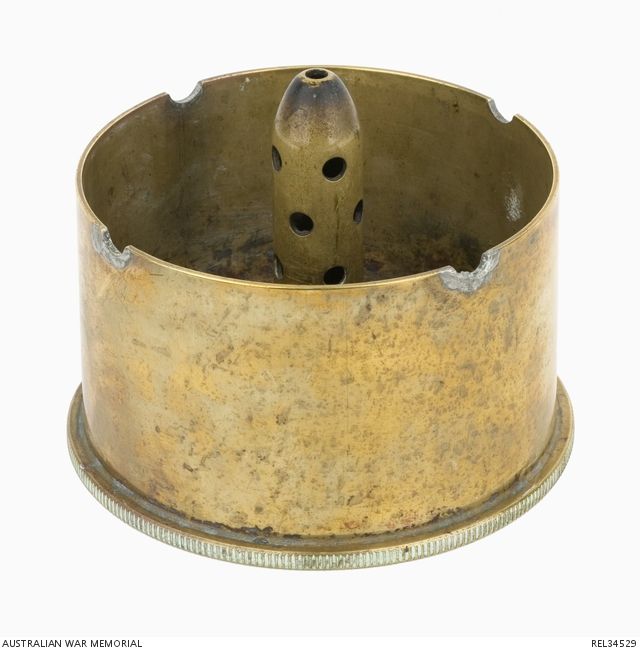| Places | |
|---|---|
| Accession Number | REL34529 |
| Collection type | Heraldry |
| Object type | Trench Art |
| Maker |
Humphery, Horace |
| Date made | 1942-1945 |
| Conflict |
Second World War, 1939-1945 |
Trench art ashtray: Able Seaman Horace Humphery, HMAS Quiberon, RAN

Brass trench art ashtray, made from a cutdown 4.7 inch cordite case. Four grooves have been shaped into the rim of the ashtray for resting cigarettes. There appear to have been holders attached to these grooves to keep the cigarettes in place but these are now missing. However there is still solder evident on the ashtray. Stamped on the the base are the calibre, gun and mark of the empty case. The year of manufacture, batch number and maker's initials are also present. The case has been fired only once. The primer is still intact.
This ashtray was made by PA3044 Able Seaman Horace Humphery from a 4.7 inch cordite case while he was serving onboard HMAS Quiberon a "Q" Class destroyer. The main armament for the "Q" Class detstroyers consisted of four single 4. 7 inch QF MkIX guns mounted on a MkXVIII mounting which had a maximum elevation of forty degrees. HMAS Quiberon was one of eight Q Class destroyers built for the Royal Navy, although Quiberon was commissioned in the Royal Australian Navy at Cowes, Isle of Wight, on 6 July 1942. Following commissioning and manned by an Australian crew, Quiberon proceeded to Scapa Flow. In October 1942 the ship formed a unit of the large British naval forces assigned to support the Allied landings in North Africa (Operation Torch). On 28 November 1942, while operating off the Tunisian coast north west of Bone in company of HMS Quentin, Quiberon attacked and destroyed the Italian submarine Dessie. On 1 December 1942 Quiberon formed a unit of a force of three cruisers and three destroyers despatched from Bone, Tunisia, to intercept an enemy convoy reported bound from Sicily to Tunis. Contact was made in the early hours of 2 December and all four ships of the convoy and the escorting Italian destroyer Lupo were sunk, HMAS Quentin was sunk by an aircraft torpedo on the way back to Bone and at dawn Quiberon, while under heavy air attack, was called upon to rescue Quentin’s complement. Quiberon operated in North African waters on convoy and fleet escort duties for the remainder of December 1942 and throughout January 1943. On 21 December the ship took off survivors from the burning liner Strathallan which had been torpedoed off the Algerian coast by a U-Boat. At the end of January 1943 Quiberon left the Mediterranean as a unit of the escort of a convoy bound from England to Capetown. The convoy arrived at Durban on 27 February and from there Quiberon proceeded to Australia, arriving at Fremantle on 29 March, having steamed 51,000 miles on war service. After refitting at Melbourne, Quiberon returned to the Indian Ocean and at Kilindini, Kenya, in June 1943 joined the British Eastern Fleet. In 1944 the ship continued serving as an escort destroyer of the Eastern Fleet protecting convoys proceeding mainly between India and Aden. Quiberon took part in the carrier air strikes against Sabang in April 1944 and Sourabaya in May 1944, before returning to Australia for another refit at Melbourne. Quiberon rejoined the Eastern Fleet at Trincomalee, Ceylon, on 1 August 1944 and resumed escort duty in the Indian Ocean. In October 1944 the ship took part in a series of fleet bombardments of the Japanese held Nicobar Islands. In mid December Quiberon detached from the Eastern Fleet and returned to Australia, where for the next few weeks she operated as an escort and anti-submarine vessel on the Australia Station. In March 1945 Quiberon proceeded to Manus, the United States base in the Admiralty Islands, as a unit of the British Pacific Fleet. From Manus the ship proceeded north to the operational area and was thereafter until the end of hostilities actively engaged in the closing phases of the war at sea against Japan. Quiberon took part in operations in support of the American seizure of Okinawa and subsequent attacks on the Japanese homeland. When the war ended in August, Quiberon had steamed 236,000 miles on war service. Quiberon’s service career ended when the ship was paid off to Reserve on 26 June 1964. Quiberon was sold on 15 February 1972 for breaking up to Fujita Salvage Company Limited of Osaka, Japan, for $68,260.00. On 10 April 1972 the Japanese tug Sumi Maru No 38 left Sydney for Japan with Quiberon and another former RAN vessel, Tobruk, in tow. Humphery was born on 16 December 1924 at Enfield in South Australia. He enlisted in the Royal Australian Navy on 28 July 1942 and served on both HMAS Quiberon and HMAS Torrens. Humphery was discharged on 14 August 1945.